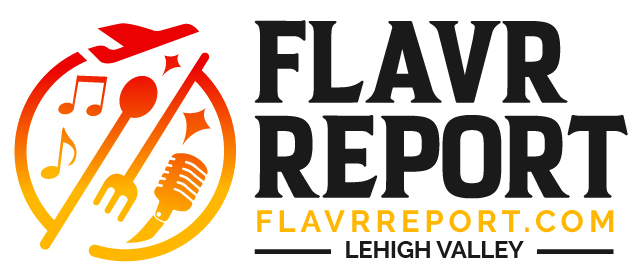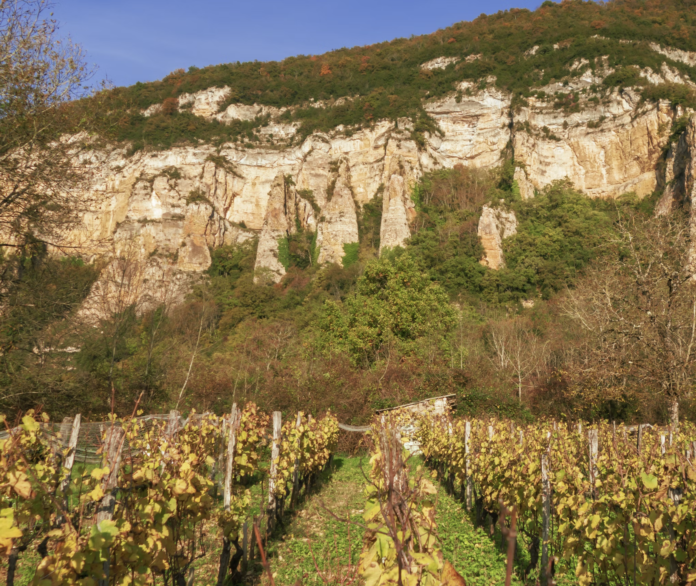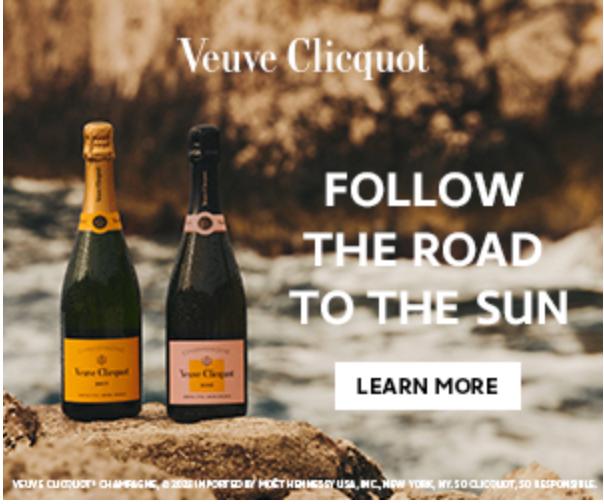From A Wine Lover’s Bucket List: Eve Bushman spends a week touring and tasting in Chateauneuf du Pape
What’s on your Bucket List?
While a normal person wants to check off going to Mars, driving a racecar or meeting a president, wine writers have lists that almost always include visiting wineries in far off places. Having Shiraz in Australia, Tempranillo in Spain, Chianti Classico in Italy and Malbec in Argentina are on our lists, but top of the list for me has always been France. I had two days in Bordeaux years ago and a week in the Garda DOC in Italy that just wet my whistle for more, so when a small group of wine writers was being put together, to visit Chateauneuf du Pape for arguably the best Rhone wines in the world, I poised my pencil over my list and made a huge mark – YES, please, take me!
Quick travel tips: Bottles are priced much less at the source, even with shipping costs; we saved in buying a case to have sent home. If you can’t get winery appointments, or don’t have the time, we found several tasting rooms in town – as well as several places for meals. None of us in our party spoke fluent French, and though it would have helped, we were fine communicating in English. You can drive your own car, on the right side of the street, but there are many roundabouts, toll roads and narrow roadways.
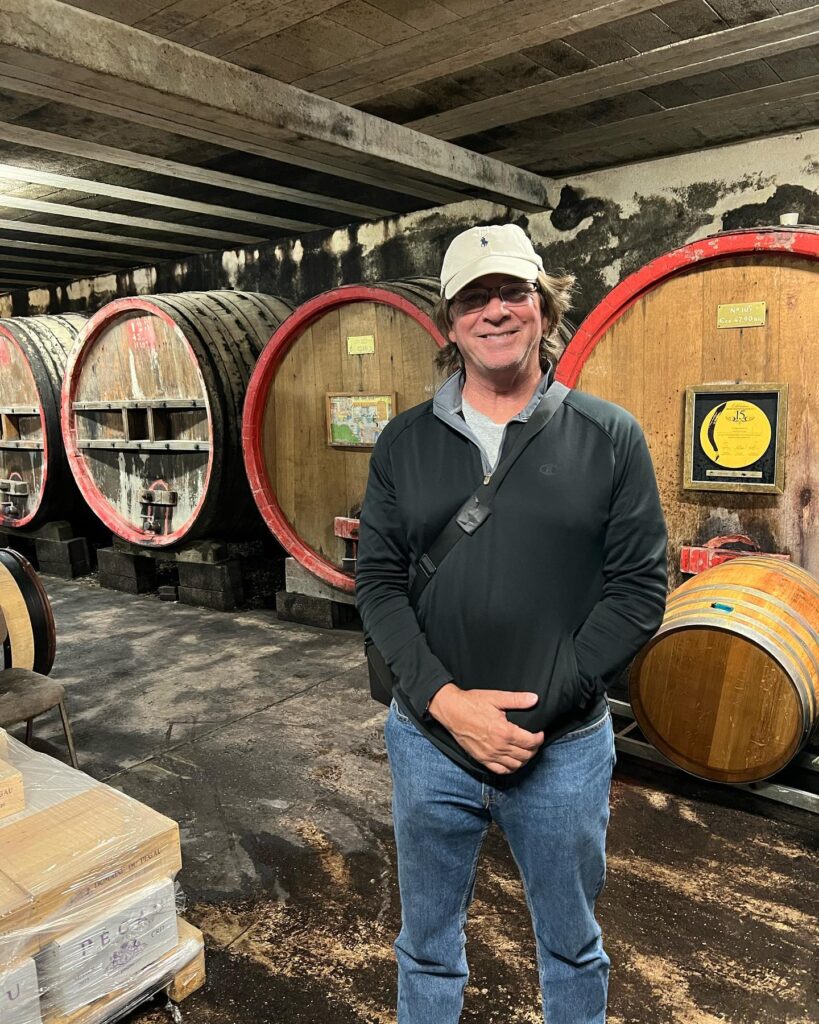
Domaine Pegau
Our first day in France began with a sunrise at our friend’s Villa in Monoblet. From there we traveled 90 minutes for a tour and tasting at Chateau (wines labeled from the Cote du Rhone area) and Domaine (Chateauneuf du Pape area in Rhone) from Pegau. We have a few Domaine Pegau wines in our cellar and really looked forward to visiting the real deal.
From our host we learned that there are five towns in Chateauneuf du Pape that produced 95% red and 5% white wine grapes. They use 13 grape varieties and any given bottle only has to use one grape. Pegau – properly pronounced as “Pay-Go” – uses all 13, including blending white with red grapes. For their Cote du Rhone property Pegau makes 44% red wine and one Rose wine.
We learned that they are an old school winery, as far as winemaking techniques. When finished wine is ordered only then is a bottling truck ordered and labels created. (There are different laws for different labeling around the world, so that is the reason they have to wait to print the labels.)
Only old oak is used for aging and some barrels are 90 years old. Stainless steel tanks are only used for their white wines; some high-end whites also spend time in wood barrels and concrete eggs. They do not de-stem any of the wines, which for me meant that the terroir would show earthiness and tannins.
Now, onto the tasting!
We sampled two Chateau Pegau Vallee du Rhone and two Domaine Pegau Chateauneuf du Pape, a white and red in each category, aged between 2019 and 2021. My personal preference on these leaned more toward the Chateauneuf du Pape wines and of particular note was the 2019 Cuvee Reservee that used all 13 Rhone grapes and 80% of that was Grenache. These wines were priced between 10 and 45 euros – which is pretty close to the same in American dollars.
Instagram: @Domaine_Du_Pegau
Website: https://pegau.com/

Domaine Roger Sabon
Next up we visited Chateauneuf du Pape’s (CDP’s) Domaine Roger Sabon for a tasting.
Our host explained that this past summer they experienced drier weather producing smaller berries over 18 hectares. Sabon, like Pegau, has both a Domaine for the CDP wine area and a Cotes du Rhone label. Five percent of their appellations are producing white wines. They blend before aging, have four different soil types and also have a distillery. All of their wines are at least 70% Grenache and are aged in large barrels.
For the tasting they offered us new and older wines, including wines from the Lirac appellation – not in Chateauneuf du Pape – with amazing aromatics and flavors.
My favorites were a 2020 Chateauneuf du Pape Reserve that had just been bottled in March and contained 80% Grenache and the remaining 20% was made of Syrah and Mourvedre – the classic GSM blend. I noted delicate fruit aromas and subtle fruit flavors – red to blue fruits – as well as a pepperiness.
My second favorite was the Prestige label, a 2020 Chateauneuf du Pape that was all black fruit, cracked pepper and earth that had a nice sweet spot. That blend was also a GSM.
My ultimate favorite of the day was the final wine we tasted: the 2012 Prestige that had huge aromatics with earth, mint, dark fruit and an extra long finish. It was a real treat to be treated to an older vintage as it showed how well these wines did after a decade of aging.
Instagram: @Roger.Sabon
Website: http://www.domainerogersabon.com/en/

Domaine de la Mordoree
The next day we went to Domaine de la Mordoree for an extensive vineyard tour – with the most amazing rocky and sandy soil that walking on it was difficult. The idea of the roots below, struggling for water that made them strong, left a huge impression on me. I had never seen this kind of large rocky terrain in a vineyard before. And the sandy sections were so pure and soft, it was quite a difference. The vines are between 40 and 60 years old.
Farming in the Domaine was certified organic in 2013 and is now also biodynamic. There are 30 workers brought in for nighttime harvests every year. The father and head of the household had died, and the mother and daughter “continue in a masculine world” according to our guide.
After the tour we had a tasting of their new white, rose and red wines. My first favorite was the 2019 La Dame Rousse – Lirac, also known as “The Red Lady” on their website, which was 50% Grenache and 50% Syrah. Very dark berries, forest floor, tannin, dry and spicy and with a price tag of only 14.50 Euros. My second favorite was their 2020 La Reine de bois Chateauneuf du Pape that was rich, velvety, smooth and balanced. Top notch indeed and 56 Euros.
Instagram: @Domaine_Mordoree
Website: https://www.domaine-mordoree.com/?lang=en
Domaine Andre Brunel and le Clos du Caillou
Our next day in Chateauneuf du Pape was spent at Domaine Andre Brunel and le Clos du Caillou! At Andre Brunel we learned that the namesake had passed away in February and his son Fabrice, Andre’s longtime apprentice, then took over as winemaker. Some of the Grenache vineyards are 135 years old. One other interesting fact is that in a recent blind tasting of a 1959 Andre Brunel vintage the wine was thought to have been a Burgundy instead of a Rhone!

We tasted in the winery, during a day of noisy pressing, but it didn’t keep us from enjoying several wines. Along with their Chateauneuf du Pape label we also sampled blends from their Cotes du Rhone Villages. My favorite was a 2020 Chateauneuf du Pape Les Cailloux that was a 60% Grenache blend with Syrah, Mourvedre and Cinsault. The wine had been aged in a Burgundy barrel.
Onto le Clos du Caillou where some of their wines are grown within the CDP boundaries and some are outside of it in Cotes du Rhone territory. The Cailloux area, mentioned above in a wine from Andre Brunel, is just outside of CDP but has the same soil and terroir. Some of their vineyards have sandy soils and some are pebbly.
Their Grand Reserve wine is their most famous and comes from pure sandy soils, which for the winery means:
“elegance, fine tannins and aging potential.”

Their new winery, Domaine de Panisse, began in 2020 and the wines have all sold out. In 2007 they went organic and were certified as so in 2010. They are also biodynamic but are not yet certified for that distinction. Grenache is their number one produced grape, followed by Syrah, Mourvedre and other Rhônes. They only work with used barrels.
We tasted seven wines and the most memorable one for me was the Les Quartz Rouge – Chateauneuf du Pape 2020 for its fresh red fruit, richness and smooth balance. The grapes used – 80% Grenache and 20% Syrah – came from the vineyard that just happened to be just outside of the Chateauneuf du Pape region. Our host said the wine had a 20-year aging potential. The wine was priced at 55 Euros.
Instagram: @Domaine_AndreBrunel @ClosDuCaillou
Websites: https://domaine-andre-brunel.fr/
https://www.closducaillou.com/

Domaine la Barroche and Château Mont Redon PLUS The Terroir and Castles
Next up we visited Domaine la Barroche where the sandy soil with quartz stones took over the vineyards. The same 12 people do the harvest every year; and the group also sorts the grapes in buckets by hand for the 2,000 cases of wine they produce a year. During the de-stemming process they discard any too-dry berries. Then, later, the winemaking process is “like slow cooking at low temperatures” according to our host.
We tasted wines from their Liberty (stones), Julien Barrot (signature) and Fiancée labels. Every wine I tasted I noted as distinguished: the 2020, 2019 and 2016 Julien Barrot Chateauneuf du Pape, 2020 Liberty blend and the 2020 Fiancée Chateauneuf du Pape.
Chateau Mont- Redon
Before our tasting at Mont-Redon I took a few moments to look over their colorful brochure and large maps.
I read,
“The secret of our skill is hidden in the poor soils in which the vines grow.
Originally the Alps, Chateauneuf du Pape, round puddings stones are what make our wines special.
Our Lirac and Cotes du Rhone are at their best on the plains, also stony, neighboring those of Chateauneuf du Pape.”
Château Mont Redon will be celebrating their 100-year anniversary next year, with the same family at the helm since 1923!
We tasted a 2021 Roussanne Viognier Reserve Cotes du Rhone, 2020 Oratoire St. Domaine Martin Rhone Valley, 2020 Lirac GSM, 2018 Reserve Gigondas and a 2020 Chateauneuf du Pape. Learned that they don’t export their wines until they are at least five years old – as the U.S. consumer is not known for aging their wines – and we should be buying the 2019s now.
Terroir tour Day Courtesy A 2 Pas des Vignes Hebergements and Spa
Next up was a fabulous tour of the different rocks – including beautiful quartz – and different soils all throughout the Cote Du Rhone and Chateauneuf du Pape with Nicolas of “A 2 Pas des Vignes Hebergements and Spa”! (He and his wife Emilie own four homes to rent, and a spa on the premises.) Castles – all minutes away – include the Pope’s Palace, Chateau de Vaudieu, Chateau La Nerthe and Hostellerie du Château that also has a lovely restaurant. I highly recommend a stay at 2 Pas as the pricing is more than reasonable as well as being in the center of Chateauneuf du Pape. Nicolas offered us the tour, though he is not a tour guide, but I also suggest a tour so that you can get more of a sense of the terroir and history.
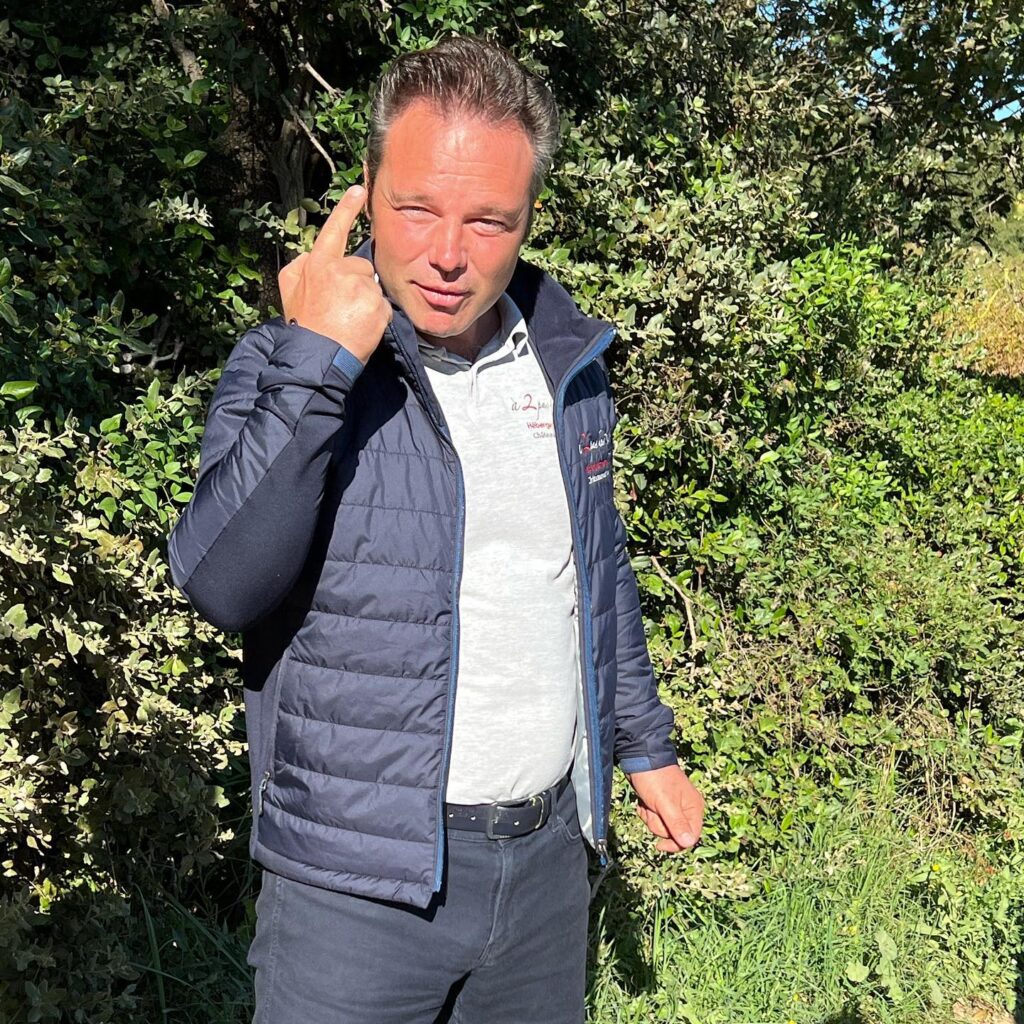
Instagram: @DomaineLaBarroche @ChateauMontRedon
Websites: https://www.domainelabarroche.com/
https://www.chateaumontredon.com/
Instagram: @a2pasdesvignes
Website: https://sites.google.com/view/a2pasdesvignes

Domaine du Grand Tinel, Domaine Saint Prefert Et Domaine Isabel Ferrando and Vieux Telegraphe
My final installment from my time in Chateauneuf du Pape is a visit and tour at Domaine du Grand Tinel that’s been making wine for 7 generations! (My husband Eddie covered me for another day – see his coverage from Domaine Saint Prefert Et Domaine Isabel Ferrando and Vieux Telegraphe below.)
Lucien Jeune, born in 1904, is known for two things, first he passed a law forbidding UFOs from landing in the vineyards – making the area more appealing to inquisitive tourists – and he was also mayor for 25 years. Grand Tinel began in 1972, combining estates owned by Lucien Jeune and Georges Establet, when their children married in 1968.
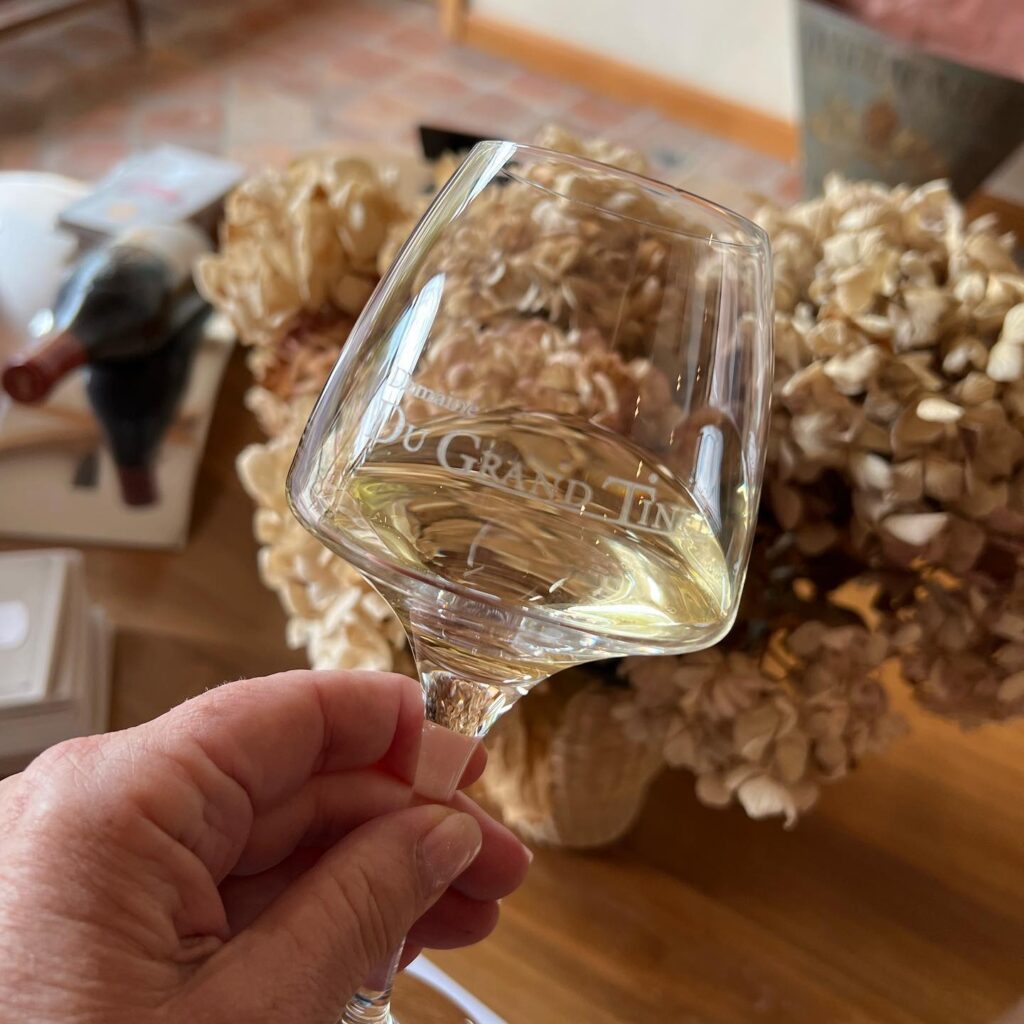
To this day harvest is all done by hand, the have two wineries from two different terroirs: Domaine du Grand Tinel and Domaine de Saint Paul. They don’t make all of the white Rhone varieties, and they focus on the three major reds: Grenache, Syrah and Mourvedre. Some of their vines are over 100 years old. They only use new oak barrels for the whites and used for the reds. Wine is sold through Negotiants, mostly to the private sector of French buyers. Bottling and labeling is done in house.
These were my favorites from the tasting: The 2020 Chateauneuf du Pape Blanc, the 2020 Cuvee Cotes du Rhone (Roussanne based), Domaine Saint Paul 2019 Chateauneuf du Pape (Grenache and Syrah based, 70 year old vines), 2018 L’insolite (100% Syrah) and 2006 Chateauneuf du Pape Cuvee Heres (100% Grenache).
Eddie and friends (I was back at the Villa with a cold) visited Domaine Saint Prefert Et Domaine Isabel Ferrando and Vieux Telegraphe…these are his memories of the day:

My day began at Domaine Saint Prefert and with an introduction and discussion with owner Isabel Fernando, and a tasting of the latest vintages. The 2021 Blanc Famille Isabel Fernando Chateauneuf du Pape was a great sample of their wines. The 2020 Colombis from Chateauneuf du Pape was outstanding as well.
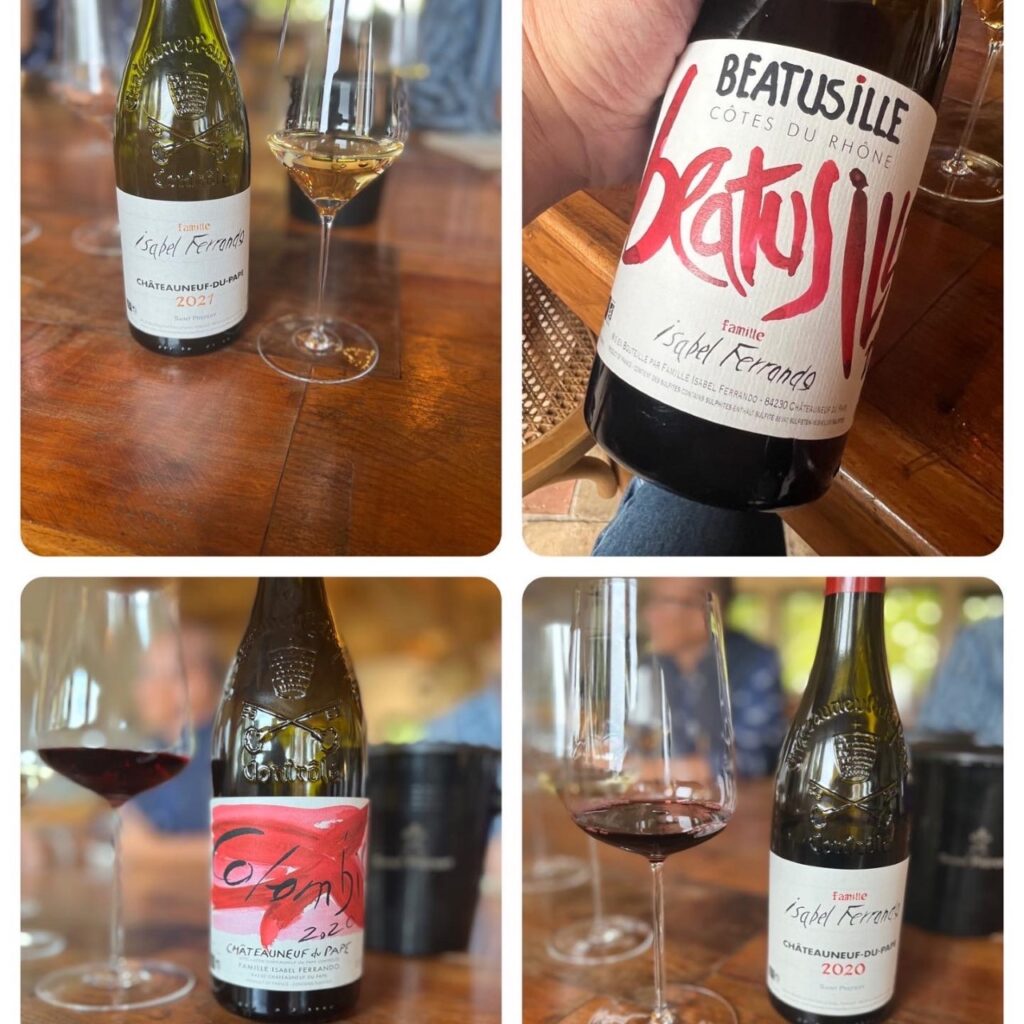
The afternoon brought us to Domaine du Vieux Telegraphe. Vieux Telegraphe has been a family run winery since 1891. The sixth generation of the Brunier family is continuing the tradition of making excellent wines. Daniel Brunier gave us a wonderful tour and explanation of their winemaking style. The tour included a walk through their newly constructed caves for wine aging and storage.
The tasting began with Clos Roquete, a very approachable wine made from 33% Roussanne, 33% Clairette, and 34% Grenache Blanc. This wine was so good, we bought a bottle for dinner that night. The 2020 Blanc was outstanding as well. We tasted the entire flight ending with the 2019 Rouge Chateauneuf du Pape made from 65% Grenache Noir, 15% Mourvedre, 15% Syrah, with Cinsault, Clairette and others at 5%. As a special treat, Daniel opened their 2010 rouge Vieux Telegraphe Chateauneuf du Pape. This wine was truly a standout in all the wines tasted on the trip so far. The wine had aged well and still had the ability go age a couple of dozen more years. Many Vieux Telegraphe wines were included in the case we had shipped home.
Instagrams: @DomaineDuGrandTinel @isabelferrando_stprefert @VieuxTelegraphe
Websites: https://www.domainegrandtinel.fr/en/#historique
https://www.vieux-telegraphe.fr/
Eve Bushman has a Level Two Intermediate Certification from the Wine and Spirits Education Trust (WSET), a “certification in the first globally-recognized course” as an American Wine Specialist ® from the North American Sommelier Association (NASA), Level 1 Sake Award from WSET, was the subject of a 60-minute Wine Immersion video (over 16k views), authored “Wine Etiquette for Everyone” and has served as a judge for the Long Beach Grand Cru and the Global Wine Awards. You can email Eve@EveWine101.com to ask a question about wine or spirits.
